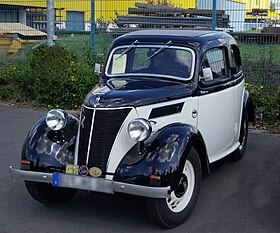Ford Eifel
| Ford Eifel | |
|---|---|
 |
|
| Overview | |
| Manufacturer | Ford-Werke GmbH |
| Also called | Ford 5/34 (reflecting tax horsepower / actual horsepower) |
| Production | July 1935 – 1940 62,495 cars |
| Assembly | Niehl, Cologne |
| Body and chassis | |
| Class | Small family car (C) |
| Body style | saloon/sedan, cabrio-limousine (soft top saloon/sedan), cabriolet, roadster |
| Layout | FR layout |
| Powertrain | |
| Engine | 1172 cc side-valve 4-cylinder 4-stroke |
| Transmission | 3-speed manual |
| Dimensions | |
| Wheelbase | 2,286 mm (90.0 in) |
| Length | 4,000 mm (160 in) 3,850 mm (152 in) (roadster) |
| Width | 1,430 mm (56 in) |
| Height | 1,600 mm (63 in) (saloon & "cabrio-limousine") 1,465 mm (57.7 in) (roadster) 1,420 mm (56 in) (cabriolet) |
| Chronology | |
| Predecessor | Ford Köln |
| Successor | Ford Taunus |
The Ford Eifel is a car manufactured by Ford Germany between 1935 and 1940. It initially complemented and then replaced the Ford Köln. It was itself replaced by the Ford Taunus.
Between 1937 and 1939 it was also assembled in Hungary and Denmark. The Eifel was derived from the Ford Model C (Europe) 1934 platform, and is also related to the Dagenham built 1938 Ford Prefect 1939 Ford Anglia.
The model was named after the Eifel mountain range in western Germany.
The car was offered with many different body types, including a two-door sedan, a two-door cabrio coach, two- and four-seat cabriolet, two-seater roadster and a light truck. The mainstream "limousine" (saloon) steel bodies were bought in from the Ambi Budd factory in Berlin, while the "cabrio-Limousine" (soft-top saloons/sedans) were built by of Heilbronn. Several other body builders such as of Dresden provided the less mainstream bodies.
The engine was a four-cylinder, four-stroke side-valve 1172 cc unit, giving a claimed maximum power output of 34 hp (25 kW) at 4250 rpm. The three-speed manual gear box featured synchromesh on the top two ratios.
61,495 Ford Eifels were produced in Germany, representing more than half of the output of the company's Cologne factory between production of the plant's first car in 1933 and the cessation of passenger car manufacture in 1942, following the outbreak, in 1939, of widespread European war. It was therefore in large measure due to this car's popularity that Ford Germany moved from eighth place in terms of German passenger car sales in 1933 to fourth place in 1938, in the process overtaking Adler, Hanomag, Wanderer and BMW.
...
Wikipedia
